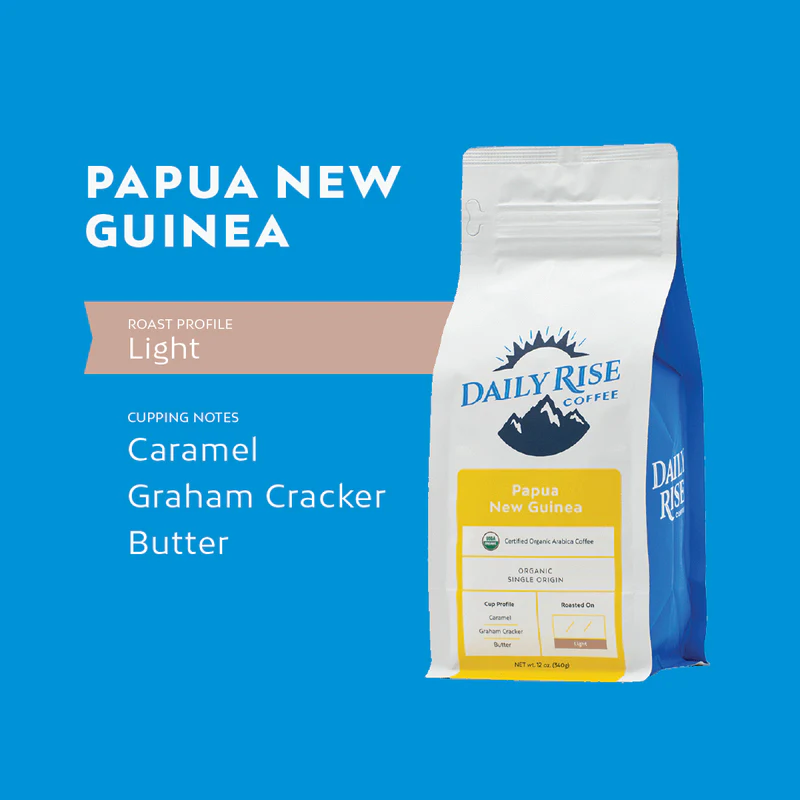Papua New Guinea Coffee: A Rich Tapestry of Flavor, Culture, and Craftsmanship

The Origins of Papua New Guinea Coffee: Deep Roots in Volcanic Soil
Papua New Guinea (PNG) is one of the world’s most captivating coffee-producing nations, offering beans grown in an exotic terrain that remains largely untouched by modern mechanization. Nestled in the eastern half of the island of New Guinea, PNG boasts rich volcanic soil, abundant rainfall, and high altitudes — perfect conditions for cultivating Arabica coffee of the highest caliber.
Coffee was introduced to PNG in the 1920s, with the Jamaican Blue Mountain variety making its way into the highlands. Since then, it has flourished as the backbone of rural livelihoods and one of the country’s most important agricultural exports. Today, PNG coffee is synonymous with clean, bright flavors, fruity undertones, and a smooth, chocolatey finish.

Unique Growing Regions of Papua New Guinea Coffee
Eastern Highlands
The Eastern Highlands is home to Goroka, the heart of PNG’s coffee production. With elevations reaching 1,600 to 2,100 meters, this area produces beans celebrated for their balanced acidity, medium body, and floral, citrus notes. The cool climate and misty conditions slow bean maturation, enhancing their complexity and sweetness.
Western Highlands
Mount Hagen in the Western Highlands is another key region, renowned for full-bodied coffees with bold earthy flavors, hints of cocoa, and mild spice. Farms here are typically smallholder plots, where generations of families use traditional methods to hand-pick and process beans.
Chimbu and Morobe Provinces
These less commercialized regions yield exceptionally clean coffees. Beans from Chimbu are often bright and fruity, while those from Morobe can carry honey and nutty undertones, making them a favorite among specialty roasters.
Sustainable Farming Practices and Community Impact
Over 87% of PNG coffee is grown by smallholder farmers who own fewer than 1,000 trees. These farmers rely heavily on organic practices, not by certification, but by tradition and necessity. Chemical fertilizers and pesticides are rarely used, giving PNG coffee a de facto organic status.
These farmers often operate in remote areas accessible only by footpaths, making logistics a challenge. Yet, their dedication to quality is unparalleled. Organizations and cooperatives have been instrumental in training farmers in sustainable practices, improving post-harvest processing, and ensuring fair trade certification where possible.
Coffee production empowers communities by providing stable income, improved infrastructure, and educational opportunities. Each cup of PNG coffee directly supports these resilient farming families.
Processing Methods: Washed, Natural, and Honey
The majority of PNG coffee is fully washed, enhancing its crisp acidity and clean finish. Water is abundant in the highlands, allowing for effective wet processing that removes mucilage and reduces the risk of fermentation defects.
Natural processing, where beans are dried inside the cherry, is gaining traction in lower-altitude areas, producing fruit-forward cups with jammy sweetness and deeper body.
Honey processing, a hybrid method, is also emerging. It involves drying beans with some of the mucilage still intact, resulting in balanced acidity, creamier mouthfeel, and unique flavor profiles prized by specialty buyers.
Flavor Profile of Papua New Guinea Coffee
PNG coffee is often described as a bridge between the clean, floral qualities of East African beans and the bold, chocolatey richness of Indonesian coffee. Tasting notes commonly include:
- Bright citrus (lemon, orange zest)
- Stone fruits (peach, apricot)
- Chocolate and cocoa
- Nutty undertones
- Mild earthiness
- Floral aromas
The versatility of PNG coffee makes it ideal for espresso, pour-over, French press, and cold brew, offering a balanced yet vibrant cup no matter the brewing method.
- Whats New
- Shopping
- Wellness
- Sports
- Theater
- Religion
- Party
- Networking
- Music
- Literature
- Art
- Health
- الألعاب
- Food
- Drinks
- Fitness
- Gardening
- Dance
- Causes
- Film
- Crafts
- Other/General
- Cricket
- Grooming
- Technology

